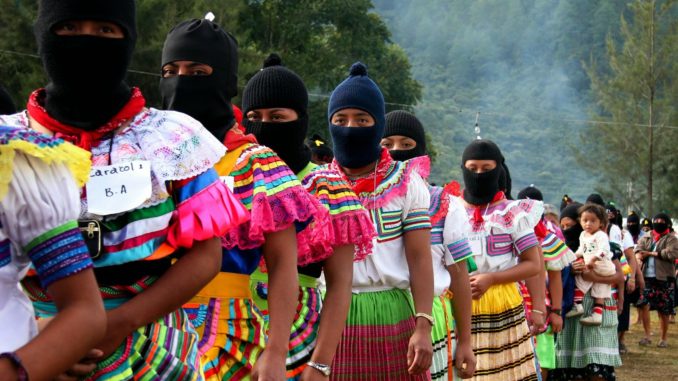Pablo Martínez*

In the Mexican southeast there are countless living languages stemming from different linguistic branches, but mostly from that of the Maya. It is interesting to observe the resistance of the Mayan language and its variants to the onslaught of a State apparatus that continues pushing for the disappearance of the native cultures. One of them is the Tojolabal language, found primarily on the Comitec plateau.
Tojolobal is one of the approximately 30 Mayan languages that are currently recognized. According to statistics, there are 34 thousand speakers that live in the region of the municipalities of Las Margaritas, Comitán, Altamirano, Trinitaria, and Maravillas Tenejapa among others. The name Tojolobal means straight talk, a word that is heard without deception, as it is composed of the word tojol , which means true, straight, correct, just, or right; and abal which refers to the word that is heard or the speech that is given.
Language gives us the possibility of observing the organizing principles that the speakers of languages perceive, organize their world (reality principle) while structuring their language. It is these linguistic-social forms that have been constructed in the Tojolabal communities that have formed relationships nosótricas (collective, or we relationships), as quoted by linguist Carlos Lenkersdorf. These relationships are formed from the word tik which means we, this being a distinctive of the Mayan language and of all the people. The linguist himself would quote that “the we predominates not only in speaking but also in life, in acting, in the way of being of the people.”
This “we” linguistic element (tik) is the one that establishes intersubjective relations. This means that it lacks an object, therefore, the dialogue is always between subjects, in Tojolabal there is no object, there are pure subjects that interrelate and complement each other. Making relationships much more horizontal, breaking with the hierarchy between subject and object (e.g. nature is not an object, but a subject). We will bring the example proposed by Carlos Lenkersdorf to understand intersubjectivity, with the phrase: les dije ( kala awab’yex):
The Spanish phrase is composed of the following syntactic elements: les, personal pronoun, third person plural, indirect object; dij(e), transitive verb, to say, active voice, indicative, preterite; e, suffix added to the verb that points to the implied subject of the first person singular, I. On the other hand, the Tojolabal: k- agential prefix of the first person singular, I. This I represents the first subject; – ala, vowel agential verb (decir), completive aspect; aw, agential prefix of the second person, completed by the suffix – yex, which points to the plural of the same person (ustedes). This prefix represents the second subject; – ab’, root of the verb ab’i (to listen, to hear, etc.).
– Carlos Lenkersdorf
Therefore, in Spanish, when expressing something to someone, one thinks only of the action of a single subject (singular or plural). The other (also singular or plural) to whom something is said plays a subordinate role. Grammatically, it is the indirect object. It does not have any action. On the other hand, in the Tojolabal language this action becomes bidirectional, having two agential subjects: “I” and “you all”. Each of them performs the action that corresponds to him/her. The first I said and the second they listened. As Javier Paredes Maella quotes: The Indo-European language uses only one verb to give verbal expression to the event; the Mayan language, on the other hand, uses two verbs, corresponding to two actions.
It is this characteristic of intersubjectivity within the language that is proposed as a principle of reality for the Tojolabal people, everything that surrounds them belongs to the we, the dialogue with the elements of nature, the forms of justice, the distribution of work, etc., would seek to start from a more horizontal form. Therefore, it would seek ways that those actions and their development be based on the common well being and care for nature, so that concepts such as justice and welfare would be based on a collective and not an individualistic vision.
Perhaps this is one of the elements of resistance of the Mayan peoples, who have been able to confront an Inquisitorial state apparatus that seeks to impose a language, ways of relating, ways of seeing life, unifying education, etc., and despite this, the Tojolabal communities continue to speak their language, resisting nosótricamente.
* Teacher
This article was published in La Jornada on February 8th, 2023. https://www.jornada.com.mx/2023/02/08/opinion/016a2pol
English translation by Schools for Chiapas.
